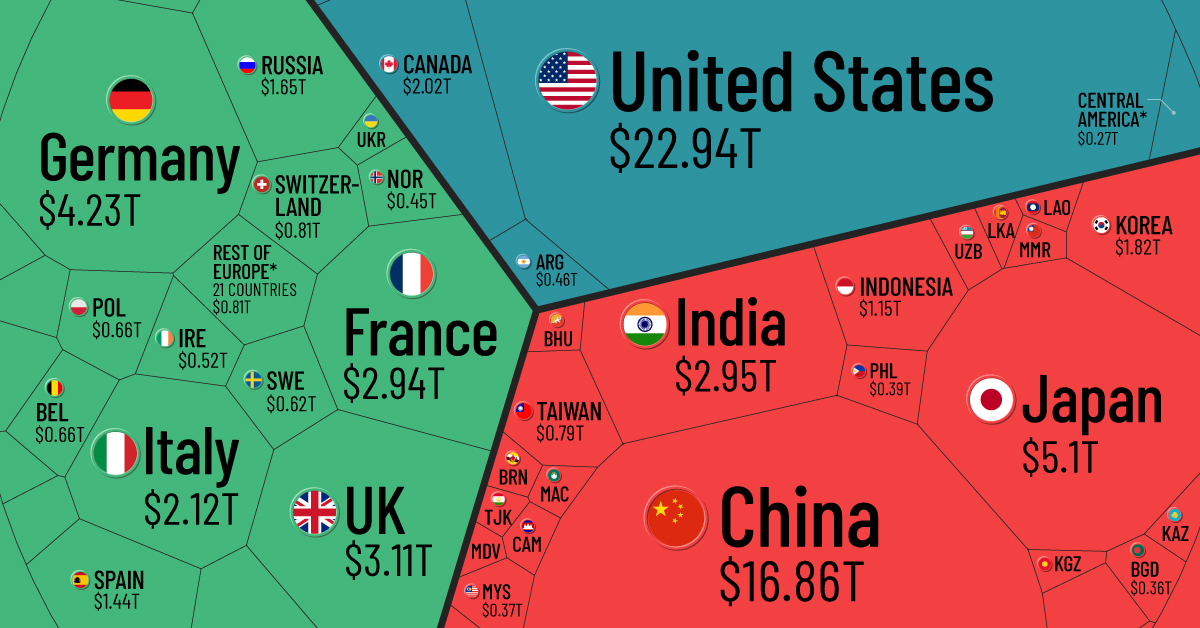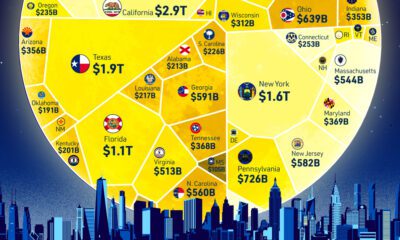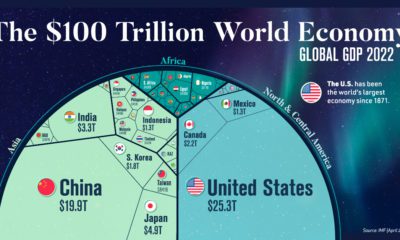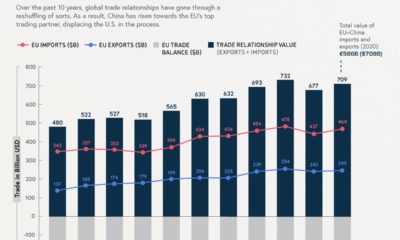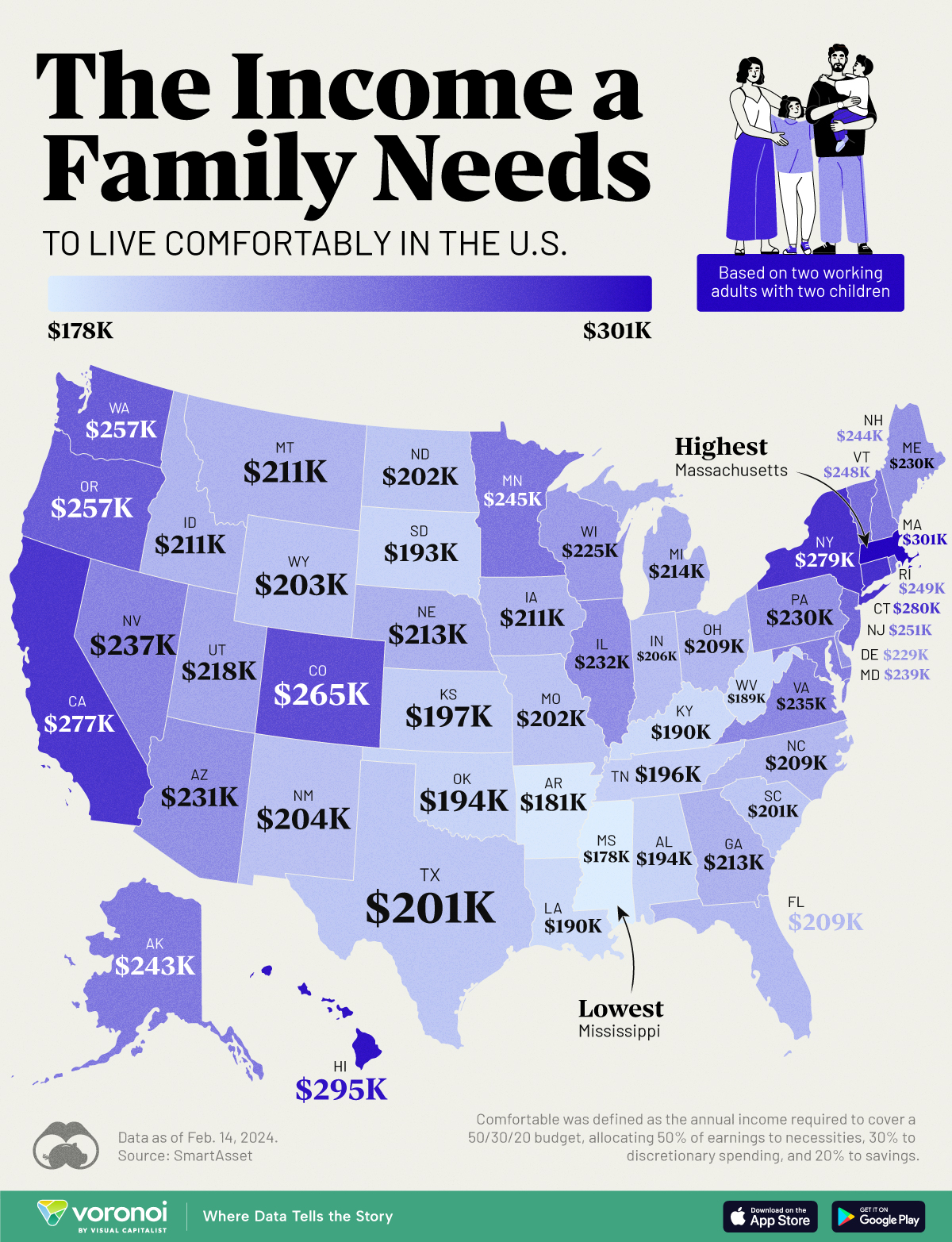Money
Visualizing the $94 Trillion World Economy in One Chart
Check out the latest 2023 update of the world economy in one chart.
View the expanded version of this infographic to see all countries.
The $94 Trillion World Economy in One Chart
Check out the latest 2023 update of the world economy in one chart.
Just four countries—the U.S., China, Japan, and Germany—make up over half of the world’s economic output by gross domestic product (GDP) in nominal terms. In fact, the GDP of the U.S. alone is greater than the combined GDP of 170 countries.
How do the different economies of the world compare? In this visualization we look at GDP by country in 2021, using data and estimates from the International Monetary Fund (IMF).
An Overview of GDP
GDP serves as a broad indicator for a country’s economic output. It measures the total market value of final goods and services produced in a country in a specific timeframe, such as a quarter or year. In addition, GDP also takes into consideration the output of services provided by the government, such as money spent on defense, healthcare, or education.
Generally speaking, when GDP is increasing in a country, it is a sign of greater economic activity that benefits workers and businesses (while the reverse is true for a decline).
The World Economy: Top 50 Countries
Who are the biggest contributors to the global economy? Here is the ranking of the 50 largest countries by GDP in 2021:
| Rank | Country | GDP ($T) | % of Global GDP |
|---|---|---|---|
| 1 | 🇺🇸 U.S. | $22.9 | 24.4% |
| 2 | 🇨🇳 China | $16.9 | 17.9% |
| 3 | 🇯🇵 Japan | $5.1 | 5.4% |
| 4 | 🇩🇪 Germany | $4.2 | 4.5% |
| 5 | 🇬🇧 UK | $3.1 | 3.3% |
| 6 | 🇮🇳 India | $2.9 | 3.1% |
| 7 | 🇫🇷 France | $2.9 | 3.1% |
| 8 | 🇮🇹 Italy | $2.1 | 2.3% |
| 9 | 🇨🇦 Canada | $2.0 | 2.1% |
| 10 | 🇰🇷 Korea | $1.8 | 1.9% |
| 11 | 🇷🇺 Russia | $1.6 | 1.7% |
| 12 | 🇧🇷 Brazil | $1.6 | 1.7% |
| 13 | 🇦🇺 Australia | $1.6 | 1.7% |
| 14 | 🇪🇸 Spain | $1.4 | 1.5% |
| 15 | 🇲🇽 Mexico | $1.3 | 1.4% |
| 16 | 🇮🇩 Indonesia | $1.2 | 1.2% |
| 17 | 🇮🇷 Iran | $1.1 | 1.1% |
| 18 | 🇳🇱 Netherlands | $1.0 | 1.1% |
| 19 | 🇸🇦 Saudi Arabia | $0.8 | 0.9% |
| 20 | 🇨🇭 Switzerland | $0.8 | 0.9% |
| 21 | 🇹🇷 Turkey | $0.8 | 0.8% |
| 22 | 🇹🇼 Taiwan | $0.8 | 0.8% |
| 23 | 🇵🇱 Poland | $0.7 | 0.7% |
| 24 | 🇸🇪 Sweden | $0.6 | 0.7% |
| 25 | 🇧🇪 Belgium | $0.6 | 0.6% |
| 26 | 🇹🇭 Thailand | $0.5 | 0.6% |
| 27 | 🇮🇪 Ireland | $0.5 | 0.5% |
| 28 | 🇦🇹 Austria | $0.5 | 0.5% |
| 29 | 🇳🇬 Nigeria | $0.5 | 0.5% |
| 30 | 🇮🇱 Israel | $0.5 | 0.5% |
| 31 | 🇦🇷 Argentina | $0.5 | 0.5% |
| 32 | 🇳🇴 Norway | $0.4 | 0.5% |
| 33 | 🇿🇦 South Africa | $0.4 | 0.4% |
| 34 | 🇦🇪 UAE | $0.4 | 0.4% |
| 35 | 🇩🇰 Denmark | $0.4 | 0.4% |
| 36 | 🇪🇬 Egypt | $0.4 | 0.4% |
| 37 | 🇵🇭 Philippines | $0.4 | 0.4% |
| 38 | 🇸🇬 Singapore | $0.4 | 0.4% |
| 39 | 🇲🇾 Malaysia | $0.4 | 0.4% |
| 40 | 🇭🇰 Hong Kong SAR | $0.4 | 0.4% |
| 41 | 🇻🇳 Vietnam | $0.4 | 0.4% |
| 42 | 🇧🇩 Bangladesh | $0.4 | 0.4% |
| 43 | 🇨🇱 Chile | $0.3 | 0.4% |
| 44 | 🇨🇴 Colombia | $0.3 | 0.3% |
| 45 | 🇫🇮 Finland | $0.3 | 0.3% |
| 46 | 🇷🇴 Romania | $0.3 | 0.3% |
| 47 | 🇨🇿 Czech Republic | $0.3 | 0.3% |
| 48 | 🇵🇹 Portugal | $0.3 | 0.3% |
| 49 | 🇵🇰 Pakistan | $0.3* | 0.3% |
| 50 | 🇳🇿 New Zealand | $0.2 | 0.3% |
*2020 GDP (latest available) used where IMF estimates for 2021 were unavailable.
At $22.9 trillion, the U.S. GDP accounts for roughly 25% of the global economy, a share that has actually changed significantly over the last 60 years. The finance, insurance, and real estate ($4.7 trillion) industries add the most to the country’s economy, followed by professional and business services ($2.7 trillion) and government ($2.6 trillion).
China’s economy is second in nominal terms, hovering at near $17 trillion in GDP. It remains the largest manufacturer worldwide based on output with extensive production of steel, electronics, and robotics, among others.
The largest economy in Europe is Germany, which exports roughly 20% of the world’s motor vehicles. In 2019, overall trade equaled nearly 90% of the country’s GDP.
The World Economy: 50 Smallest Countries
On the other end of the spectrum are the world’s smallest economies by GDP, primarily developing and island nations.
With a GDP of $70 million, Tuvalu is the smallest economy in the world. Situated between Hawaii and Australia, the largest industry of this volcanic archipelago relies on territorial fishing rights.
In addition, the country earns significant revenue from its “.tv” web domain. Between 2011 and 2019, it earned $5 million annually from companies—including Amazon-owned Twitch to license the Twitch.tv domain name—equivalent to roughly 7% of the country’s GDP.
| Countries | Region | GDP (B) |
|---|---|---|
| 🇹🇻 Tuvalu | Oceania | $0.07 |
| 🇳🇷 Nauru | Oceania | $0.1 |
| 🇵🇼 Palau | Oceania | $0.2 |
| 🇰🇮 Kiribati | Oceania | $0.2 |
| 🇲🇭 Marshall Islands | Oceania | $0.2 |
| 🇫🇲 Micronesia | Oceania | $0.4 |
| 🇨🇰 Cook Islands | Oceania | $0.4* |
| 🇹🇴 Tonga | Oceania | $0.5 |
| 🇸🇹 São Tomé and Príncipe | Africa | $0.5 |
| 🇩🇲 Dominica | Caribbean | $0.6 |
| 🇻🇨 St. Vincent and the Grenadines | Caribbean | $0.8 |
| 🇼🇸 Samoa | Oceania | $0.8 |
| 🇰🇳 St. Kitts and Nevis | Caribbean | $1.0 |
| 🇻🇺 Vanuatu | Oceania | $1.0 |
| 🇬🇩 Grenada | Caribbean | $1.1 |
| 🇰🇲 Comoros | Africa | $1.3 |
| 🇸🇨 Seychelles | Africa | $1.3 |
| 🇦🇬 Antigua and Barbuda | Caribbean | $1.4 |
| 🇬🇼 Guinea-Bissau | Africa | $1.6 |
| 🇸🇧 Solomon Islands | Oceania | $1.7 |
| 🇹🇱 Timor-Leste | Asia | $1.7 |
| 🇱🇨 St. Lucia | Caribbean | $1.7 |
| 🇸🇲 San Marino | Europe | $1.7 |
| 🇨🇻 Cabo Verde | Africa | $1.9 |
| 🇧🇿 Belize | Central America | $1.9 |
| 🇬🇲 Gambia | Africa | $2.0 |
| 🇪🇷 Eritrea | Africa | $2.3 |
| 🇱🇸 Lesotho | Africa | $2.5 |
| 🇧🇹 Bhutan | Asia | $2.5 |
| 🇨🇫 Central African Republic | Africa | $2.6 |
| 🇸🇷 Suriname | South America | $2.8 |
| 🇦🇼 Aruba | Caribbean | $2.9 |
| 🇧🇮 Burundi | Africa | $3.2 |
| 🇦🇩 Andorra | Europe | $3.2 |
| 🇸🇸 South Sudan | Africa | $3.3 |
| 🇱🇷 Liberia | Africa | $3.4 |
| 🇩🇯 Djibouti | Africa | $3.7 |
| 🇸🇱 Sierra Leone | Africa | $4.4 |
| 🇸🇿 Eswatini | Africa | $4.5 |
| 🇲🇻 Maldives | Asia | $4.6 |
| 🇫🇯 Fiji | Oceania | $4.6 |
| 🇧🇧 Barbados | Caribbean | $4.7 |
| 🇸🇴 Somalia | Africa | $5.4 |
| 🇲🇪 Montenegro | Europe | $5.5 |
| 🇱🇮 Liechtenstein | Europe | $6.8* |
| 🇬🇾 Guyana | South America | $7.4 |
| 🇲🇨 Monaco | Europe | $7.4* |
| 🇹🇯 Tajikistan | Asia | $8.1 |
| 🇰🇬 Kyrgyz Republic | Asia | $8.2 |
| 🇹🇬 Togo | Africa | $8.5 |
*2019 GDP (latest available) used where IMF estimates for 2021 were unavailable.
Like Tuvalu, many of the world’s smallest economies are in Oceania, including Nauru, Palau, and Kiribati. Additionally, several countries above rely on the tourism industry for over one-third of their employment.
The Fastest Growing Economies in the World in 2021
With 123% projected GDP growth, Libya’s economy is estimated to have the sharpest rise.
Oil is propelling its growth, with 1.2 million barrels being pumped in the country daily. Along with this, exports and a depressed currency are among the primary factors behind its recovery.
| Rank | Country | Region | 2021 Real GDP Growth (Annual % Change) |
|---|---|---|---|
| 1 | 🇱🇾 Libya | Africa | 123.2% |
| 2 | 🇬🇾 Guyana | South America | 20.4% |
| 3 | 🇲🇴 Macao | Asia | 20.4% |
| 4 | 🇲🇻 Maldives | Asia | 18.9% |
| 5 | 🇮🇪 Ireland | Europe | 13.0% |
| 6 | 🇦🇼 Aruba | Caribbean | 12.8% |
| 7 | 🇵🇦 Panama | Central America | 12.0% |
| 8 | 🇨🇱 Chile | South America | 11.0% |
| 9 | 🇵🇪 Peru | South America | 10.0% |
| 10 | 🇩🇴 Dominican Republic | Caribbean | 9.5% |
Ireland’s economy, with a projected 13% real GDP growth, is being supported by the largest multinational corporations in the world. Facebook, TikTok, Google, Apple, and Pfizer all have their European headquarters in the country, which has a 12.5% corporate tax rate—or about half the global average. But these rates are set to change soon, as Ireland joined the OECD 15% minimum corporate tax rate agreement which was finalized in October 2021.
Macao’s economy bounced back after COVID-19 restrictions began to lift, but more storm clouds are on the horizon for the Chinese district. The CCP’s anti-corruption campaign and recent arrests could signal a more strained relationship between Mainland China and the world’s largest gambling hub.
Looking Ahead at the World’s GDP
The global GDP figure of $94 trillion may seem massive to us today, but such a total might seem much more modest in the future.
In 1970, the world economy was only about $3 trillion in GDP—or 30 times smaller than it is today. Over the next thirty years, the global economy is expected to more or less double again. By 2050, global GDP could total close to $180 trillion.
Correction: In earlier versions of this graphic, countries such as Vietnam and Pakistan were inadvertently not included in the visualization. They have now been added. In cases where the IMF has no data for 2021 (specifically Pakistan, Syria, Afghanistan, and Lebanon), the latest available data is used.
Personal Finance
Mapped: The Income a Family Needs to Live Comfortably in Every U.S. State
Families in expensive states require over $270,000 annually to live comfortably.
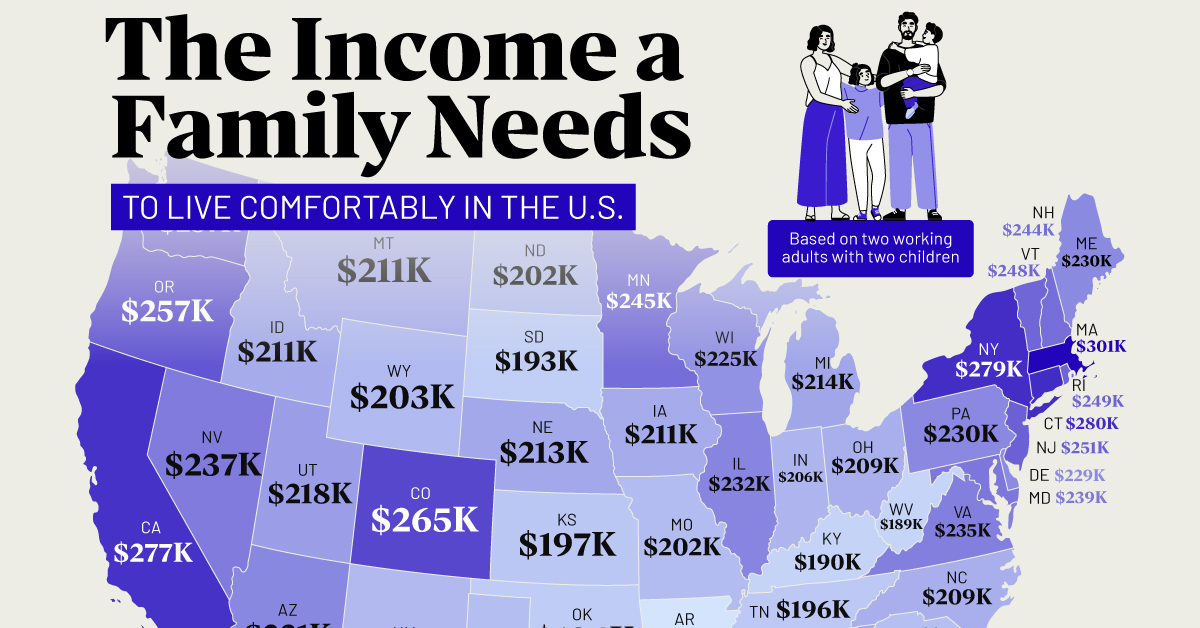
The Income a Family Needs to Live Comfortably in Every U.S. State
This was originally posted on our Voronoi app. Download the app for free on iOS or Android and discover incredible data-driven charts from a variety of trusted sources.
Families in the top five most expensive U.S. states require an annual income exceeding $270,000 to live comfortably.
This visualization illustrates the income necessary for two working adults with two children to maintain a comfortable lifestyle in each state.
“Comfortable” is defined as the income needed to cover a 50/30/20 budget, with 50% allocated to necessities like housing and utilities, 30% to discretionary spending, and 20% to savings or investments.
The calculations for family income needed in each state were done by SmartAsset, using the cost of necessities sourced from the MIT Living Wage Calculator, last updated on Feb. 14, 2024.
Massachusetts Tops the List
Massachusetts is the most expensive state to live comfortably in, requiring a total family income of about $301,184. Hawaii ($294,611) comes in second, followed by Connecticut ($279,885).
Housing is one main reason Massachusetts is an expensive state to live in, particularly in the Boston area. In addition, the state also has a high cost of living, including expenses such as healthcare and utilities.
| Rank | State | Income for 2 working adults raising 2 children |
|---|---|---|
| 1 | Massachusetts | $301,184 |
| 2 | Hawaii | $294,611 |
| 3 | Connecticut | $279,885 |
| 4 | New York | $278,970 |
| 5 | California | $276,723 |
| 6 | Colorado | $264,992 |
| 7 | Washington | $257,421 |
| 8 | Oregon | $257,338 |
| 9 | New Jersey | $251,181 |
| 10 | Rhode Island | $249,267 |
| 11 | Vermont | $248,352 |
| 12 | Minnesota | $244,774 |
| 13 | New Hampshire | $244,109 |
| 14 | Alaska | $242,611 |
| 15 | Maryland | $239,450 |
| 16 | Nevada | $237,286 |
| 17 | Virginia | $235,206 |
| 18 | Illinois | $231,962 |
| 19 | Arizona | $230,630 |
| 20 | Pennsylvania | $230,464 |
| 21 | Maine | $229,549 |
| 22 | Delaware | $228,966 |
| 23 | Wisconsin | $225,056 |
| 24 | Utah | $218,483 |
| 25 | Michigan | $214,490 |
| 26 | Nebraska | $213,075 |
| 27 | Georgia | $212,826 |
| 28 | Montana | $211,411 |
| 28 | Iowa | $211,411 |
| 30 | Idaho | $211,245 |
| 31 | North Carolina | $209,331 |
| 31 | Ohio | $209,331 |
| 33 | Florida | $209,082 |
| 34 | Indiana | $206,003 |
| 35 | New Mexico | $203,923 |
| 36 | Wyoming | $203,424 |
| 37 | Missouri | $202,259 |
| 38 | North Dakota | $202,176 |
| 39 | Texas | $201,344 |
| 40 | South Carolina | $200,762 |
| 41 | Kansas | $196,768 |
| 42 | Tennessee | $195,770 |
| 43 | Oklahoma | $194,106 |
| 44 | Alabama | $193,606 |
| 45 | South Dakota | $192,608 |
| 46 | Kentucky | $190,112 |
| 47 | Louisiana | $189,613 |
| 48 | West Virginia | $189,363 |
| 49 | Arkansas | $180,794 |
| 50 | Mississippi | $177,798 |
Meanwhile, Mississippi is the least expensive state for a family to live comfortably, requiring $177,798 per year. Arkansas ($180,794) comes in second, followed by West Virginia ($189,363). In common, all these states share low prices of housing.
Learn More About Cost of Living From Visual Capitalist
If you enjoyed this post, be sure to check out this graphic, which ranks the median down payment for a house by U.S. state.
-

 China2 weeks ago
China2 weeks agoWhich Countries Have the Most Economic Influence in Southeast Asia?
-

 Brands2 weeks ago
Brands2 weeks agoHow Popular Snack Brand Logos Have Changed
-

 War2 weeks ago
War2 weeks agoVisualized: Aircraft Carriers by Country
-

 Cannabis2 weeks ago
Cannabis2 weeks agoMapped: Countries Where Recreational Cannabis is Legal
-

 Culture2 weeks ago
Culture2 weeks agoCharted: How the Logos of Select Fashion Brands Have Evolved
-

 population2 weeks ago
population2 weeks agoMapped: U.S. States By Number of Cities Over 250,000 Residents
-

 Crime2 weeks ago
Crime2 weeks agoVisualizing Global Losses from Financial Scams
-
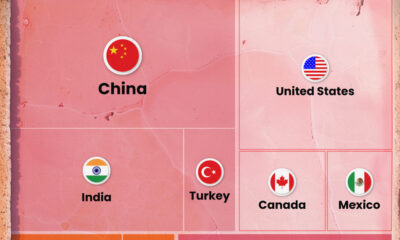
 Mining2 weeks ago
Mining2 weeks agoThe Biggest Salt Producing Countries in 2023

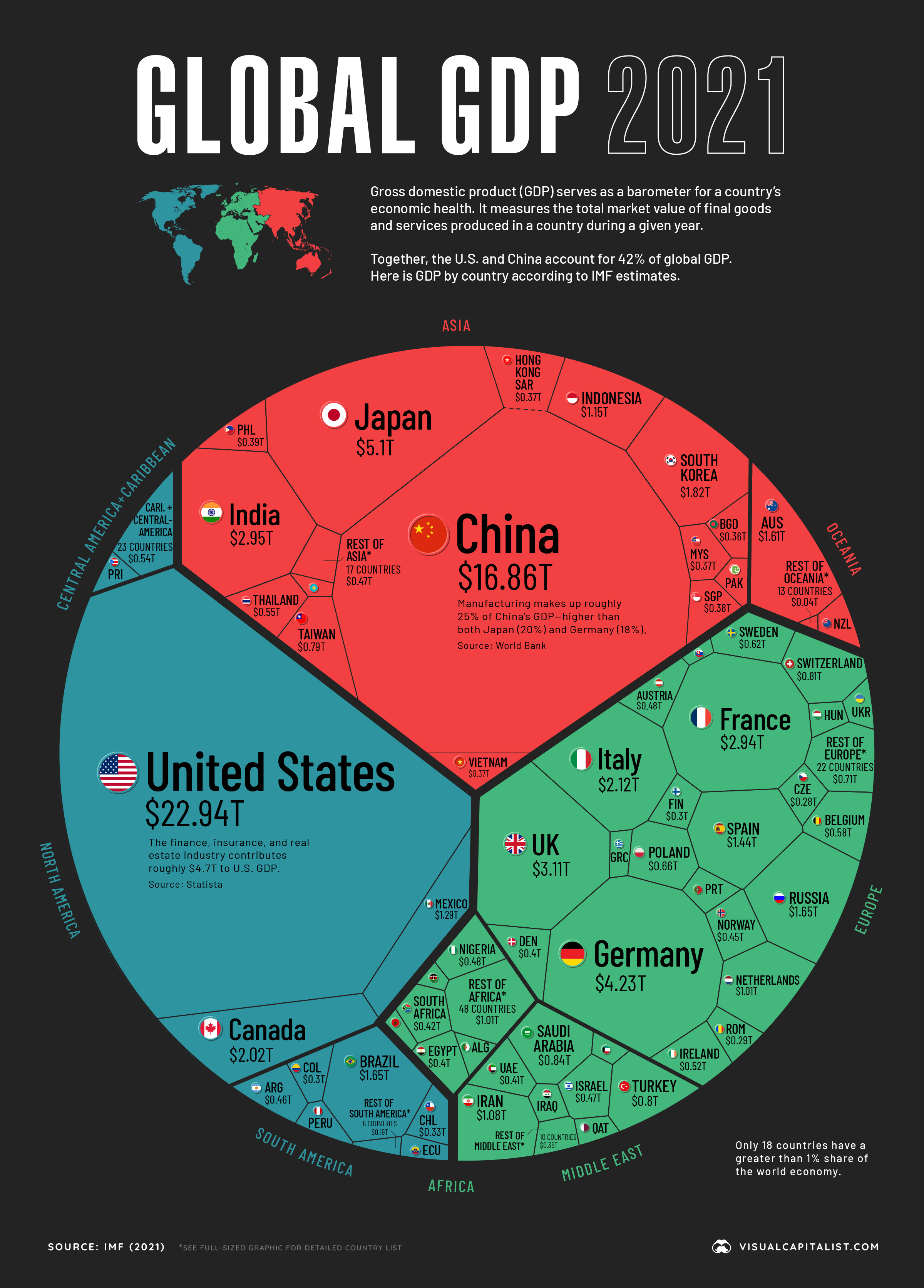
 Can I share this graphic?
Can I share this graphic? When do I need a license?
When do I need a license? Interested in this piece?
Interested in this piece?